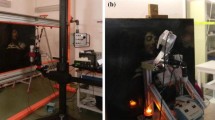Abstract
X-ray fluorescence spectrometry (XRF) allows a rapid and simple determination of the elemental composition of a material. As a non-destructive tool, it has been extensively used for analysis in art and archaeology since the early 1970s. Whereas it is commonly used for qualitative analysis, recent efforts have been made to develop quantitative treatment even with portable systems. However, the interpretation of the results obtained with this technique can turn out to be problematic in the case of layered structures such as easel paintings. The use of differential X-ray attenuation enables modelling of the various layers: indeed, the absorption of X-rays through different layers will result in modification of intensity ratio between the different characteristic lines. This work focuses on the possibility to use XRF with the fundamental parameters method to reconstruct the composition and thickness of the layers. This method was tested on several multilayers standards and gives a maximum error of 15% for thicknesses and errors of 10% for concentrations. On a painting test sample that was rather inhomogeneous, the XRF analysis provides an average value. This method was applied in situ to estimate the thickness of the layers a painting from Marco d’Oggiono, pupil of Leonardo da Vinci.



Similar content being viewed by others
References
Hocquet F-P, Garnir H-P, Marchal A, Clar M, Oger C, Strivay D (2008) A remote controlled XRF system for field analysis of cultural heritage objects. X-Ray Spectrom 37:304–308
Vittiglio G et al (2004) A compact µ-XRF spectrometer for (in situ) analyses of cultural heritage and forensic materials. Nucl Instrum Methods Phys Res B213:693–698
Moioli P, Seccaroni C (2000) Analysis of art objects using a portable X-ray fluorescence spectrometer. X-Ray Spectrom 29:48–52
Hocquet F-P, Garnir H-P, Marchal A, Clar M, Oger C, Strivay D (2006) A remote controlled XRF system for field analysis of cultural heritage objects. X-Ray Spectrom 37:304–308
Vittiglio G et al (2004) A compact µ-XRF spectrometer for (in situ) analyses of cultural heritage and forensic materials. Nucl Instrum Methods Phys Res B213:693–698
Moioli P, Seccaroni C (2000) Analysis of art objects using a portable X-ray fluorescence spectrometer. X-Ray Spectrom 29:48–52
Jenkins R (1988) X-ray fluorescence spectrometry. Wiley, London
Han XY, Zhuo SJ, Shen RX, Wang PL, Ji A(2006) Comparison of the quantitative results corrected by fundamental parameter method and difference calibration specimens in x-ray fluorescence spectrometry. J. Quantitative Spectroscopy Radiative Transf 97: p68-74
Mantler M, Schreiner M (2000) X-ray fluorescence spectrometry in art and archaeology. X-Ray Spectrom 29:3–17
Beckhoff B, Kolbe M, Hahn O, Karydas A, Zarkadas Ch, Sokaras D, Mantler M (2008) Reference-free X-ray fluorescence analysis of an ancient Chinese ceramic. X-Ray Spectrom 37:462–465
De Viguerie L, Duran A, Bouquillon A, Sole VA, Pierrat G, Castaing J and Walter P (2009) Quantitative X-Ray fluorescence analysis of an Egyptian Pendant and comparison with PIXE. Anal Bioanal Chem. doi:10.1007/s00216-009-2947-7
Smit Z, Janssens K, Proost K, Langus I (2004) Confocal µ-XRF depth analysis of paint layers, beam interactions with materials and atoms. Nucl Instr Methods Phys Res B219–220:35–40
Mantouvalou I, Malzer W, Schaumann I, Lühl L, Dargel R, Vogt C, Kanngiesser B (2008) Reconstruction of thickness and composition of stratified materials by means of 3D micro x-ray fluorescence spectroscopy. Anal Chem 80:819–826
De Boer DKG (1990) Calculation of X-ray fluorescence intensities from bulk and multilayer samples. X-Ray Spectrom 19:145–154
De Boer DKG, Borstrok JJM, Leenaers AJG, Van Sprang HA, Brouwer PN (1993) How accurate is the fundamental parameter approach? XRF analysis of bulk and multilayer samples. X-Ray Spectrom 22:33–38
Nygard K, Hamalainen K, Manninen S, Jalas P, Ruottinen JP (2004) Quantitative thickness determination using X-ray fluorescence: application to multiple layers. X-Ray Spectrom 33:354–359
Bonizzoni L, Galli A, Poldi G, Milazzo M (2007) In-situ non invasive EDXRF analysis to reconstruct stratigraphy and thickness of Renaissance pictorial multilayers. X-Ray Spectrom 36:55–61
Solé VA, Papillon E, Cotte M, Walter P, Susini J (2007) A multiplatform code for the analysis of energy-dispersive X-ray f luorescence spectra. Spectrochim Acta B 62: 63-68. (web site: http://pymca.sourceforge.net/)
Dunkerton J, Gordon SFD, Penny N (1999) Durer to Veronese, sixteenth-century painting in The National Gallery. London
Henke BL, Gullikson EM, Davis JC (1993) X-ray interactions: photoabsorption, scattering, transmission, and reflection at E = 50–30000 eV, Z = 1–92. Atom Data Nucl Data 54:181–342
Bonizzoni L, Galli A, Poldi G, Milazzo M (2007) In-situ non invasive EDXRF analysis to reconstruct stratigraphy and thickness of Renaissance pictorial multilayers. X-Ray Spectrom 36:55–61
de Viguerie L, Beck L, Salomon J, Pichon L, Walter P (2009) Composition of Renaissance paint layers: Simultaneous PIXE and Backscattering Spectrometry. Anal Chem in press
Author information
Authors and Affiliations
Corresponding author
Rights and permissions
About this article
Cite this article
de Viguerie, L., Sole, V.A. & Walter, P. Multilayers quantitative X-ray fluorescence analysis applied to easel paintings. Anal Bioanal Chem 395, 2015–2020 (2009). https://doi.org/10.1007/s00216-009-2997-0
Received:
Revised:
Accepted:
Published:
Issue Date:
DOI: https://doi.org/10.1007/s00216-009-2997-0




